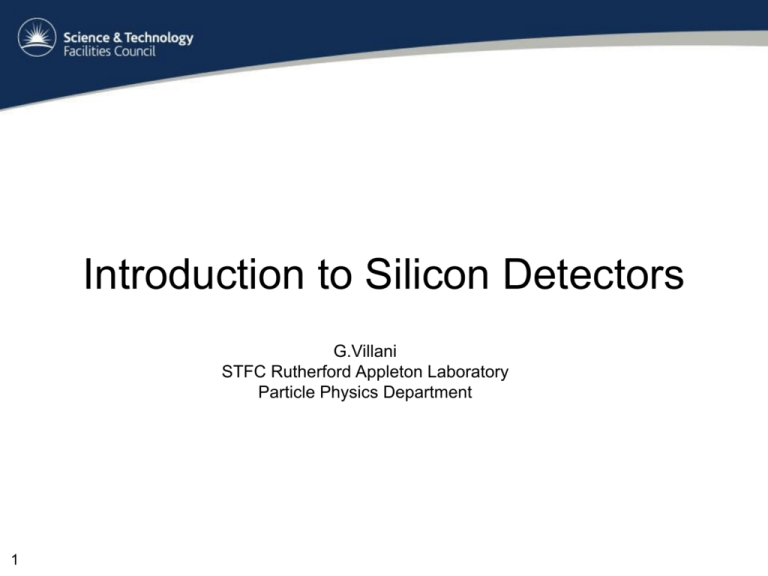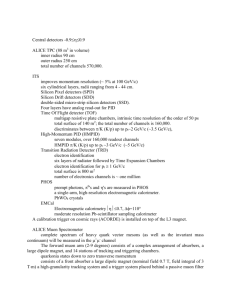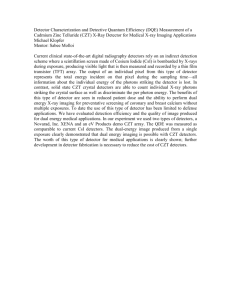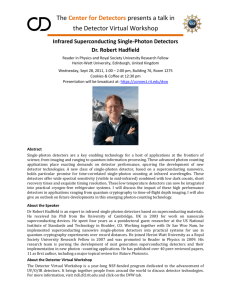Lecture 2
advertisement

Introduction to Silicon Detectors G.Villani STFC Rutherford Appleton Laboratory Particle Physics Department 1 Outlook • Introduction to physics of Si and detection • Examples of detectors • Conclusions 2 Introduction The detection chain E Sensing/ Charge creation Charge transport and collection Si physical properties Conversion Si device properties Signal processing Data TX Si device topologies properties all the boxes of the detection chain process based upon Silicon Detector examples: Silicon physical and electrical properties Microstrips Detection principles CCD Transport mechanisms MAPS Detector physics: Conversion 3 Detector system issues: Detection efficiency Power Introduction to Silicon After Oxygen, Silicon is the 2nd most abundant element in Earth’s crust (>25% in mass) The crystalline structure is diamond cubic (FCC), with lattice spacing of 5.43 A Polysilicon consists of small Si crystals randomly oriented; in α-Si there is no long range order. Si 1.48A 4 The key to success of Si is related to its oxide SiO2, an excellent insulator (BV ~ 107 V/cm). Micro crystals but the flexible bond angles make SiO2 effectively an amorphous: its conductivity varies considerably (charge transport in SiO2 via polaron hopping between non-bonding oxygen 2p orbitals) Introduction to Silicon Silicon Band structure The electronic band structure calculation can be done ab-initio using variational approach (DFT) or empirical methods (kp) that solve 1 electron SE in a periodic potential neglecting electrons interaction. The approximate solution of many-body SE in presence of periodic potential of the crystal lattice are in the form of Bloch functions: T U E n,k r un,k r e jkr En k It can be regarded as a traveling wave associated with free motion of electrons modulated by the periodic solution un,k. The energy E is periodic in k so is specified just within the 1st unit WS cell of the reciprocal lattice (the Brillouin zone). The band diagram look complicated: 5 Introduction to Silicon 1st Brillouin zone of Diamond lattice CB VB The appearance of Band Gap, separating CB and VB The 6 CB minima are not located at the center of 1st Brillouin zone, INDIRECT GAP CB Anisotropy in surface of E 6 VB-H VB-L Introduction to Silicon The detailed band structure is too complicated: quasi-equilibrium simplifications are needed to study the of mechanism charge transport. Assuming that the carriers reside near an extremum, the dispersion relationship E(k) is almost parabolic: E k 2 k 2 2m0* 2m g E * 3/ 2 0 2 3 2 E Eo the effective mass approximation takes into account the periodic potential of the crystal by introducing an effective carrier mass (in 3D an average over different longitudinal and transverse masses): 2 2 k 1 k p E k v k E k * * * 2m0 m0 m0 dk t d p rV F dt dt Under the assumptions of small variation of the electric field, the carrier dynamics resembles that one of a free particle, with appropriate simplifications. The mobility of a particle is inversely related to its effective mass (or proportional to the curvature of E(k)). Similar approach used to calculate the E(k) for phonons. 7 Introduction to Silicon Once the band structure and simplified density of states is known, it is possible to determine the carrier density. This is essential to study the charge transport. CB • The density of states g(E); • The distribution function F(E); Only partly filled bands can contribute to conduction: carrier density in CB and VB. At equilibrium the carrier density is obtained by integrating the product: VB nD g D E F E dE NC /V e Ec Ev / kT ni pi 3 F E 2 1 0 pn ni2 N C NV e E g / kT Fermi level: energy level @ 50% occupancy In intrinsic Si a creation of e in CB leaves behind a hole in VB, that can be treated as an e with positive charge and mobility of the band where it resides The density of states gD(E) depends on the dimension 8 1 E EF 1 exp kT Introduction to Silicon Conduction of Si intrinsic @ T = 300K: σ = q(μn +μp) ni = 3.04x10-6mho-cm ->329kOhm-cm By adding atoms of dopants, which require little energy to ionize, we can change by many odg the carrier concentration. Doping concentration: 1012 to 1018 cm-3 In crystalline Si ~ 5*1022atomscm-3 In equilibrium and for non degenerate case the relationship between carrier concentration and E is the same as in the intrinsic case: pn ni2 N C NV e E g / kT 1020 @ T 300K e.g . : N D 1017 pn pN D p ni2 103 ND Thermal energies at ambient temperature (~40meV) is enough to ionize the dopants 9 Detection Detection principles: A: Ionization: by imparting energy to break a bond, electrons are lifted from VB to CB then made available to conduction. Well established concept ( ionization chambers, microstrip, hybrid pixels, CCD, MAPS…) α MIP Photon interaction Bethe-Bloch formula for stopping power gives the rate of energy loss/unit length for charged particles through matter 10 I z I o e E z Detection Ph: DQ~107 m-1 DQ~1010 m-1 /a The indirect BG of Si requires higher energy for charge excitation, because energy and momentum must be conserved (Phonon-assisted pair creation/recombination) In Si an average of 3.6 eV is required for pair creation 11 Detection MIP charge density n I z I o e E z dE 1 1 3 1015 cm 3 2 dx i R R v I 110nm A MIP forms an ionization trail of radius R when traversing Si, creating ~ 80e-/μm h 1015 cm 2m E L 0.5 1107 cm Low injection regime: The associated wavelength is much smaller than mean free path: Each charge is independent from each other; Carrier dynamics does not need QM The generated charge is too small to affect the internal electric field 12 Photoelectric charge density z n Pin z e 5.6 106 e / m h An optical power of -60dBm (= 1nW) of 1keV photons generates ~ 6*106e-/μm High injection regime: Plasma effects The internal electric field can be affected by the generated charge Detection The variance in signal charge σi associated to the ionization process is related to the phonon excitation i Eo i E pn i 1 Ei Ei Fano factor ~0.1 in Si High resolution requires smaller band gap (εi ), direct or small phonon excitation energy Intrinsic resolution of Si and Ge based detectors 13 Detection B: Excitation: Charge or lattice (acoustic or optical phonons) some IR detectors, bolometers 60meV Poly Si SiO2 Si Ec EF ~10’s meV EV EF Eigenvalues separation in quantized structures ~ 10’s meV Dispersion relation for phonons in Si Phonon excitation energy ~ 10 meV : much lower threshold 14 Charge transport Charge transport: Once the charge has been created in the material, the next step is its collection: The charge transport description relies on semi-classical BTE (continuity equation in 6D phase space) f r , k , t 1 F f r , k , t k E k r f r , k , t k f r , k , t t t n r, t 1 V f r , k , t S r , k , t coll Q conservation k q vk f r , k , t V k P conservation 1 E k f r , k , t V k E conservation J r, t W r, t The distribution function f(r,k) can be approximated near equilibrium: Near equilibrium equilibrium 0 15 k f r , k , t t coll f f0 f Charge transport Under (many) simplifying assumptions the 1st momentum of BTE gives the DD model (The semiconductor equations): J n qn n E r qDnn J p qp p E r qDp p Drift term Diffusion term n 1 Jn Un t q p 1 J p U p t q V p n N D N A DD expresses momentum conservation: it becomes invalid when sharp variation in energy of carriers occur (due to F for example: deep submicron devices) When feature size is 0.’sμm the DD model becomes invalid: higher momentum required Even in low injection regime, a small F renders the drift term >> diffusion term 16 Half summary The processes in the detection chain can be simplified: E Sensing/ Charge creation Charge transport and collection Si physical properties Si device properties Physical characteristics: Charge generation: Charge transport: Quasi equilibrium; Ionization: Small injection, QM not needed; Big devices, DD adequate; Stopping power, average ionization energy Small injection, electric field as static; Homogeneity; ‘Room’ temperature; Non degenerate Si; 17 Conversion Under conditions of • quasi stationary conditions • non degenerate semiconductor • not small feature size • low injection •… Signal conversion: The pn junction Homojunction: consider two pieces of same semiconductor materials with different doping levels: In equilibrium, the Fermi level equalizes throughout the structure The thermal diffusion of charge across the junction leaves just the ionized dopants : an electric potential develops In equilibrium J = 0: using DD model 0 qnn E r qDnn n n0e D Vt 0 qp p E r qDpp p p0e 0 D Vt Near the interface, the carrier concentration exponentially drops: a depletion region (empty of free charge) is formed. A ‘positive’ voltage increases (exponentially) the charge concentration: high direct current. A ‘negative’ voltage decreases it (down to leakage): the current reduces and at the same time widens the depleted region. Unidirectional of current characteristics 18 Signal conversion: The pn junction An electric field F is present in the depletion region of a junction, sustained by the ionized dopants The electric field in the depletion region contributes to the charge drift , when generated, and helps the collection process. PN junction signal converter: A capacitor with a strong F across W A device with a large depleted region can be used to efficiently collect radiation generated charge ( Solid state ionization chamber) W 2Vb N a N d q Na Nd To achieve large W high field region: • Low doping (high resistivity) Silicon is needed • Large voltages Conversion: Q to V // Q to I 19 The bipolar transistor device A bipolar transistor can be thought of as a two diode system, connected in anti series; •One is forward biased; •The other is reverse biased The bipolar transistor can be (and it is) used as a high gain detector Main limitations arising from speed: the minority carriers diffuse through the base ( relatively low speed) 20 Detectors examples Strip detectors Scientific applications Charge Coupled Devices (CCD) Imaging, scientific and consumer applications Monolithic Active Pixel Sensors (MAPS) Imaging, consumer applications RAL PPD has (is) actively involved with all these detector technologies 21 Detectors examples Strip detectors 768 Strip Sensors 300μm 80μm P++ N+ (high res) F Wires RO electronic Vbias ~10’sV Power supply Array of long silicon diodes on a high resistivity silicon substrate A strong F in the high resistivity Si region helps collect charge efficiently. The transversal diffusion of charge implies a spread of signal over neighbouring strips The high resistivity Si is not usually used in mainstream semiconductor industry: Hybrid solution: detector connected (wirebonded) to the readout electronic (RO) 22 Detectors examples module 768 Strip Sensors RO ATLAS SCT 4 barrel layers,2 x 9 forward disks 4088 double sided modules Total Silicon surface 61.1m² Total 6.3 M channels Power consumption ~ 50kW 23 Detectors examples High events rate require fast signal collection: Estimate of charge collection time in strip detector: z 1 1 z t z dz z0 z0 v z 1 dz z Fo 1 F1 W For a detector thickness of 300um and overdepleted Vb = 50V and 10kohm resistivity tcoll(e)≈ 12ns tcoll(h)≈ 35ns The fast collection time helps the radiation hardness: Radiation damage to the Si bulk increases the recombination rate. To avoid signal loss the charge has to be collected quickly, before it recombines. 24 Detectors examples MAPS detectors ≈10’s m RO electronic RO electronic 3T ( 3MOS) MAPS structure 2D array of pixels Monolithic solution: Detector and readout integrated onto the same substrate 25 Detectors examples MAPS detectors Vbias ~V’s N++ (low res) Electronics 0.’s μm Active region P+ (low-med res) ‘s μm P++ (low res) Mechanical substrate 100’s μm The charge generated in the thin active region moves by diffusion mainly: ‘Long’ collection time Small signal Different implants arrangements for charge collection optimization Circuit topologies for low noise 26 Detectors examples Example of charge collection in MAPS: 10-7 TPAC 1 pixel size 50x50um2 Chip size ~1cm2 Total pixels 28k >8Meg Transistors n l2 2 Dn n U n tcoll t Dn Charge collection time (s) in MAPS vs. perpendicular MIP hit 27 Detectors examples Example of charge collection in MAPS: simulated MIP vs.1064nm laser 2x2um 5ns pulse 28 Detectors examples CCD detectors Once the charge has been generated, it accumulates in the potential well, under the capacitor. The control circuitry shifts the accumulated charge to the end of the row, to the input of a charge amplifier. The sensor is fabricated in a optimized, dedicated process and the RO on a separate chip. Superior imaging quality but less integration and speed. Nobel Prize 2009 for Physics to inventors Boyle and Smith 29 Detectors examples 5 m Global Photogate and Transfer gate In-situ Storage Image Sensor: ISIS ROW 2: CCD clocks ROW 3: CCD clocks On-chip logic 80 m On-chip switches ROW 1: CCD clocks Imaging pixel ROW 1: RSEL Global RG, RD, OD 55 Fe source Mn(K RG RD OD RSEL Mn(Kb Column transistor 30 CCD in CMOS process 0.18μm Charge collection under a PG then stored under a 20 pixels storage CCD Signal conversion: The unipolar MOS device NMOS SiO2 N++ P++ Metal Oxide Semiconductor device are unipolar devices based on voltage modulation of charge. The control gate is physically separated by the active region where the charge moves by a thin (nm) layer of SiO2. By applying a voltage to the G with respect to the Substrate an electric field develops across the SiO2: a charge channel is formed between Source and Drain. The Ids characteristics depends on the Vgs applied. The CMOS process refers to the minimum feature size achievable i.e. the channel length) Currently 45nm: the modelling of the characteristics of the device of this size is non-trivial: •Quantization effects at the boundary; •QM tunnelling across the gate; •Hot carriers near the D/S junction; •… 31 Sensor devices: The unipolar MOS device LET in SiO2 for different particles The SiO2 is a very good insulator: a strong electric field can be applied to it and the charge generated in SiO2 by ionizing radiation efficiently collected However SiO2 is a polar material: the recombination processes are stronger than in Si. Furthermore, hole Transport is non Gaussian (low ‘mobility’) and traps form near Si interface. 32 Generation rate in SiO2 vs. electric field Y ( Fox , T , ro ) K e 1 ( A ) ( K ) K A qFox ro kT rc q2 , rc ro 4 SiO2 kT e Am K l m 0 m! n 0 l m n 1 l! Sensor devices: The unipolar MOS device Floating Gate Control Gate Si O2 Si O2 FG FG Addition of a Floating Gate (FG): the electrical characteristics of the device are controlled by the charge stored in the FG. The electric field in the SiO2 due to the FG drifts charge towards/away from it. The discharge of the FG alters the device electrical characteristics Ids(A) Pre-rad Post-rad Reprog Radiation sensitivity Chip #2 100Gy <∆Vth > 0.6152 Std dev 0.00598 Conversion: Q to I 33 The MOS structure easily allows excitation based radiation detection Detector systems Detection efficiency: 50μm SF CA RC-CR SF Vth MAPS pixel structure can host complex electronics Estimated power consumption MAPS Calice: 10 μW/pixel x 1012= 107W Assuming Vcc=2V 10μW continuous -> 10μJ energy Energy deposited by a particle: 0.2 – 10fJ Noise occupancy 1% : hit pixel fires/100sec Required energy/deposited energy >> 1010 !!! Extremely huge energy inefficiency 34 5*106A Detector systems Power reduction at detector level = At pixel level, power consumption could be optimized by using a non linear approach: The positive feedback structure is biased near threshold (variable) A small signal triggers the structure 35 Detector systems Power optimization at system level Alternative powering schemes: SP DC2DC The ATLAS SCT (semiconductor tracker) detector. The thick red cables on show feed the detector with half of its power – adding more will take up even more space A serial powering or DC2DC approach can increase efficiency in power distribution compared to a parallel approach 36 Conclusions The field of semiconductor detectors encompasses different scientific and technology fields: solid state physics, EM, QM, electrical engineering, nuclear and particle physics… Some of the issues relevant to radiation detectors: • Development of new detection techniques based on novel and well established semiconductor material: ( phonon-based detectors, quantum detectors, compounds, low dimensional) • Integration with electronics (monolithic solution to achieve more compactness and reduce cost) 3D structures • Topologies optimization (power reduction, noise reduction) • Radiation hardness 37 Backup slides Quantization effects due to band bending in Si-SiO2 interface: excitation based detection SiO2 Si-sub Si-poly Q-effects A




